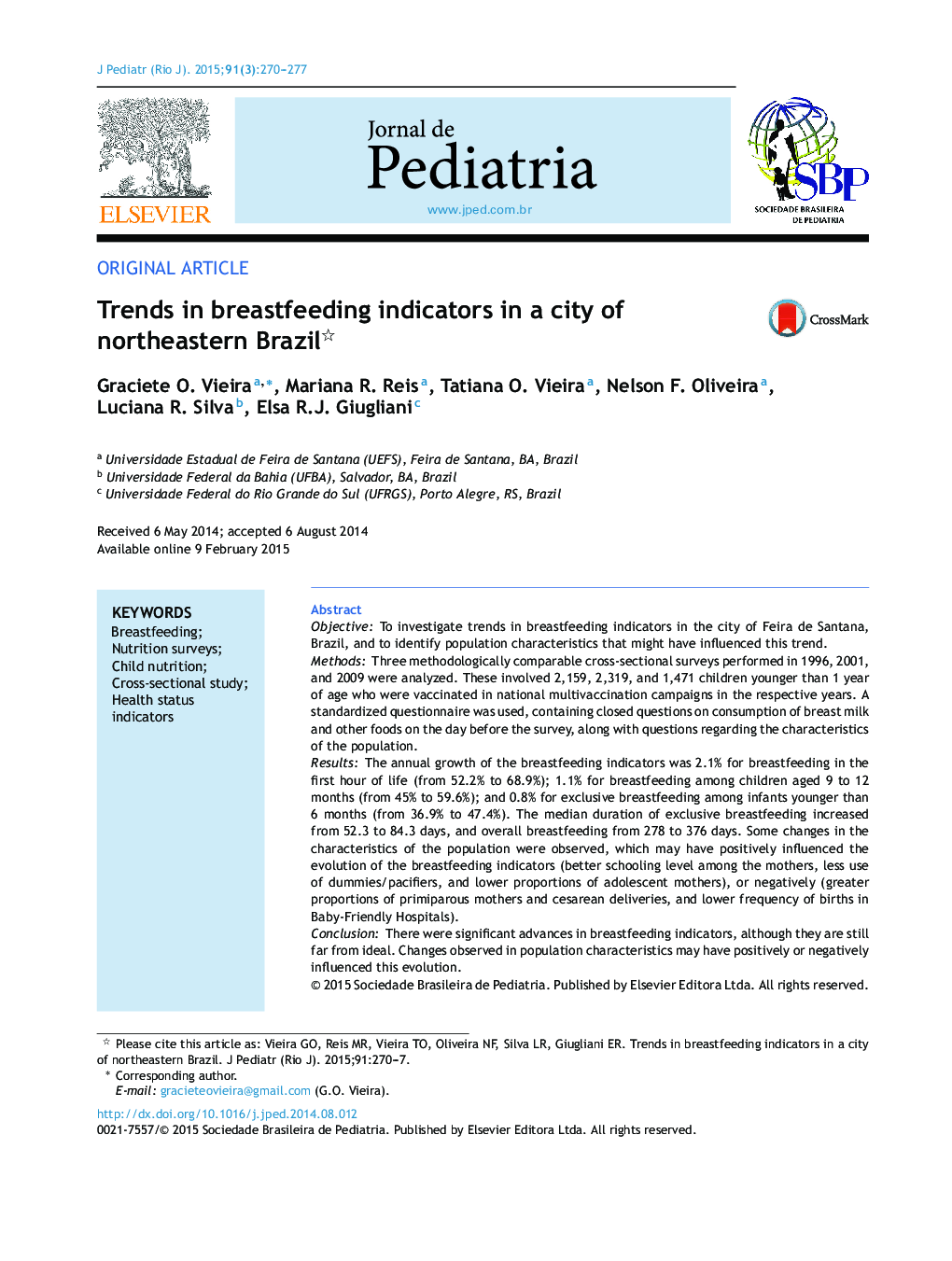| کد مقاله | کد نشریه | سال انتشار | مقاله انگلیسی | نسخه تمام متن |
|---|---|---|---|---|
| 4153865 | 1273679 | 2015 | 8 صفحه PDF | دانلود رایگان |
ObjectiveTo investigate trends in breastfeeding indicators in the city of Feira de Santana, Brazil, and to identify population characteristics that might have influenced this trend.MethodsThree methodologically comparable cross-sectional surveys performed in 1996, 2001, and 2009 were analyzed. These involved 2,159, 2,319, and 1,471 children younger than 1 year of age who were vaccinated in national multivaccination campaigns in the respective years. A standardized questionnaire was used, containing closed questions on consumption of breast milk and other foods on the day before the survey, along with questions regarding the characteristics of the population.ResultsThe annual growth of the breastfeeding indicators was 2.1% for breastfeeding in the first hour of life (from 52.2% to 68.9%); 1.1% for breastfeeding among children aged 9 to 12 months (from 45% to 59.6%); and 0.8% for exclusive breastfeeding among infants younger than 6 months (from 36.9% to 47.4%). The median duration of exclusive breastfeeding increased from 52.3 to 84.3 days, and overall breastfeeding from 278 to 376 days. Some changes in the characteristics of the population were observed, which may have positively influenced the evolution of the breastfeeding indicators (better schooling level among the mothers, less use of dummies/pacifiers, and lower proportions of adolescent mothers), or negatively (greater proportions of primiparous mothers and cesarean deliveries, and lower frequency of births in Baby-Friendly Hospitals).ConclusionThere were significant advances in breastfeeding indicators, although they are still far from ideal. Changes observed in population characteristics may have positively or negatively influenced this evolution.
ResumoObjetivoVerificar a tendência dos indicadores de aleitamento materno (AM) em Feira de Santana, Brasil, e identificar características da população que possam ter influenciado essa tendência.MétodosProcedeu-se a análise de três inquéritos transversais, metodologicamente comparáveis, realizados em 1996, 2001 e 2009, envolvendo 2.159, 2.319 e 1.471 menores de um ano vacinados na campanha nacional de multivacinação desses anos. Utilizou-se questionário contendo questões sobre o consumo de leite materno e outros alimentos no dia anterior ao inquérito, além de perguntas sobre características da população.ResultadosO acréscimo anual nos indicadores de AM foi de 2,1 pontos percentuais para o AM na primeira hora de vida (de 52,2% para 68,9%); 1,1 pontos para o AM em crianças de 9 a 12 meses (de 45% para 59,6%); e de 0,8 pontos para o AM exclusivo (AME) em menores de seis meses (de 36,9% para 47,4%). A duração mediana do AME aumentou de 52 para 84 dias, e a de AM de 278 para 376 dias. Observou-se mudanças nas características da população, as quais podem ter influenciado a evolução dos indicadores do AM de forma positiva (melhor escolaridade das mães, decréscimo no uso de chupeta e menor prevalência de mães adolescentes), ou negativa (maior proporção de mães primíparas e de cesarianas, e menor frequência de nascimentos em Hospital Amigo da Criança).ConclusãoHouve avanços significativos nos indicadores de AM em Feira de Santana, embora ainda estejam longe do ideal. Mudanças observadas nas características da população podem ter influenciado positiva ou negativamente essa evolução.
Journal: Jornal de Pediatria - Volume 91, Issue 3, May–June 2015, Pages 270–277
